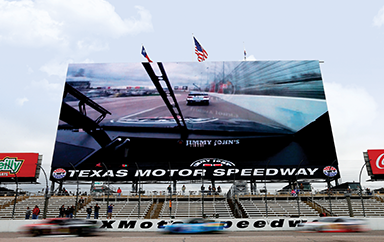Digital signage
While many ongoing analyses of LEDs have focused on their potential to displace traditional lighting systems in the sign industry and mainstream architectural applications, this can lead to misconceptions about their true value propositions, which need to be overcome. Many applications of LEDs are indeed intended to replace existing fixtures, but others are serving as new models for ‘digital light,’ exploiting ways to control light dynamically to provide information. Hence, LEDs have become highly useful in the digital signage sector.
In April 2014, Churchill Downs—the thoroughbred racetrack in Louisville, Ky., that is famous for hosting the annual Kentucky Derby—unveiled an enormous video screen built by Panasonic Enterprise Solutions. Designed to provide a clear viewing experience for everyone at the venue, including thousands of fans throughout the (26-acre) infield, the screen measures 52.1 m (171 ft) wide and 27.4 m (90 ft) tall—framing an active display area of 1,414 m2 (15,224 sf)—and sits 24.4 m (80 ft) above the ground, offering a wide viewing angle. It is positioned midway along the backstretch and outside the dirt course to avoid becoming a distraction to the jockeys and horses.
Construction of the ‘Big Board’ started in December 2013 and was completed in March 2014, in plenty of time for the Spring Meet, the Kentucky Oaks and the 140th running of the Kentucky Derby. Digging deep enough to bury 12 steel support beams into 13.7 m (45 ft) of bedrock solved local installation challenges posed by an underground river. Weighing 544 t (600 tons), the structure was built to withstand wind speeds up to 145 km/h (90 mph).
The Big Board is designed to display more than nine million lines of resolution. This gives its operators an array of creative content capabilities, ranging from replays, image close-ups, betting odds and race results to advertising, recorded programming and multiple split-screen views.
It may come as no surprise that the Big Board for Churchill Downs was named the world’s largest ‘4K’ LED-based video board by the Guinness World Records. Incidentally, a few weeks earlier, a Guinness adjudicator also officially certified Panasonic’s ‘Big Hoss TV’ screen at Texas Motor Speedway in Fort Worth, Texas, the largest LED-based high-definition (HD) TV screen in the world. Measuring 66.4 x 28.7 m (218 x 94 ft), it offers an active display area of 1,917 m2 (20,633 sf), incorporating 4.8 million pixels and capable of generating 21 trillion different colours. The 98-t (108-ton) structure rests on 16 support beams, each buried 12.2 m (40 ft) deep into bedrock.
“Sports and entertainment represent a growing business market for digital signage, including HD LED boards,” says Jim Doyle, president of Panasonic Enterprise Solutions. “This offers an excellent opportunity to deliver customized video systems.”
In the out-of-home (OOH) advertising industry, meanwhile, LED-based digital billboards—sometimes referred to as electronic billboards—are providing a more effective medium than traditional boards for marketers to reach an audience with timely and relevant messaging. For billboard operators, meanwhile, they increase revenue potential by increasing the number of messages and advertisers each location can feature. Hence, the benefits for all parties are clear.
Advertising clients in this respect can include both local and national businesses, as they may book ongoing campaigns or short-term promotions, given the dynamic nature of the medium. They can tailor their campaigns to deliver the right message to the right audience at the right time. Copy can be changed in the midst of a campaign, to better align brand communications in response to consumer trends.
CBS Outdoor Canada, for example, allows advertisers to book its digital billboards by ‘daypart’ to take advantage of different traffic patterns at different times in different cities (including Edmonton, Calgary, Regina, Saskatoon, Toronto, Ottawa and Montreal). The company encourages clients to use multiple designs to deliver creative messages and keep the public interested in their campaigns. The medium has proven an ideal complement to traditional OOH promotions, to say nothing of repurposing creative elements from online, TV or print campaigns.
For the public, too, digital billboards offer new benefits. They enable the real-time delivery of emergency notifications, for example, such as Amber Alerts, along with other announcements for travellers and/or local communities.
Typically, digital billboards update their displayed content every four to 10 seconds, often depending on local regulations. For similar reasons, most do not feature animation, flashing lights, scrolling or full-motion video, but rather switch between static images. And while these images are brighter than printed billboard graphics, they must also often meet standards that restrict their brightness levels.
As with traditional billboards, digital billboards are typically located ‘off-premise’—i.e. not on a specific business’ property to promote its own brand, but some distance away, often along a road where it will be most highly visible to traffic and/or pedestrians. The operators can then sell space on the digital billboard to a variety of third-party advertisers.
An on-premise LED sign, on the other hand, would also be located outdoors but within the premises of a given business. Smaller than a billboard and typically mounted on the building, as a monument sign or mounted on a set of posts, this type of display is used by the business owner or organization to exclusively promote its specific brand and offerings directly to the public. It is more common for these on-premise, LED-based digital signs to be allowed to feature animation, scrolling images and full-motion video, but again it depends on local zoning regulations.
Stephen Montgomery is president of ElectroniCast Consultants, which forecasts trends in LED illumination and communication networks. For more information, visit www.electronicast.com.






